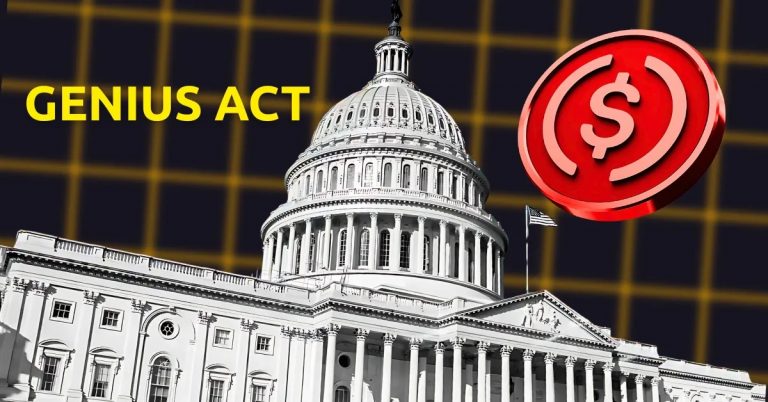
The GENIUS Act, formally the Guiding and Establishing National Innovation for US Stablecoins Act, passed the U.S. Senate on June 17, 2025, with a 68-30 vote, marking a significant step toward regulating dollar-pegged stablecoins. This bipartisan legislation, supported by 18 Democrats, establishes a federal framework requiring stablecoin issuers to maintain 1:1 reserves, conduct annual audits for issuers with over $50 billion in market cap, and comply with anti-money laundering and sanctions rules. It also prioritizes consumer protections, such as granting stablecoin holders “super-priority” in bankruptcy proceedings.
The bill now moves to the House for further consideration, where it may face challenges reconciling differences, as the House version splits oversight among multiple regulators, unlike the Senate’s Treasury-centric approach. U.S. Treasury Secretary Scott Bessent has championed the act, projecting that stablecoins could reach a $3.7 trillion market cap by 2030, up from $252 billion currently, driven by increased demand for U.S. Treasuries as reserves. He argues this could lower federal borrowing costs, boost dollar dominance in digital transactions, and help address the national debt.
However, critics like Sen. Elizabeth Warren warn of weak consumer protections and potential conflicts of interest, particularly citing President Trump’s $57 million earnings from stablecoin ventures like World Liberty Financial’s USD1. The bill’s passage has sparked debate, with some Democrats opposing it for not addressing these conflicts adequately. Treasury Secretary Scott Bessent’s projection of a $3.7 trillion stablecoin market cap by 2030 suggests significant economic potential. Stablecoins, pegged to the U.S. dollar, could drive demand for U.S. Treasuries as reserves, potentially lowering federal borrowing costs by increasing Treasury purchases.
Register for Tekedia Mini-MBA edition 19 (Feb 9 – May 2, 2026): big discounts for early bird.
Tekedia AI in Business Masterclass opens registrations.
Join Tekedia Capital Syndicate and co-invest in great global startups.
Register for Tekedia AI Lab: From Technical Design to Deployment (next edition begins Jan 24 2026).
The act strengthens the U.S. dollar’s role in global digital finance, countering competing digital currencies and reinforcing the dollar as the world’s primary reserve currency. By providing a clear regulatory framework, the act could spur innovation in blockchain-based financial services, attracting investment and fostering fintech development in the U.S. Increased demand for Treasuries could indirectly help manage the national debt by reducing borrowing costs, though this depends on stablecoin adoption and market dynamics.
The requirement for 1:1 reserves and annual audits for large issuers aims to ensure stability and transparency, reducing risks of collapse seen in past crypto failures (e.g., TerraUSD). The “super-priority” provision in bankruptcy proceedings protects stablecoin holders, potentially boosting consumer confidence but raising concerns about favoring stablecoin investors over other creditors. Anti-money laundering and sanctions compliance aligns stablecoins with traditional financial regulations, reducing illicit use but increasing compliance costs for issuers.
The act positions the U.S. as a leader in stablecoin regulation, potentially attracting global issuers to operate under a clear legal framework, unlike fragmented or stricter regimes elsewhere. However, overly stringent regulations could push innovation to jurisdictions with lighter oversight, a concern raised by some industry advocates. The bill’s passage in the Senate is a milestone, but differences with the House version (which splits oversight among multiple regulators) could delay final enactment. Reconciliation will be critical, especially given the tight timeline before the 2026 midterms.
Bipartisan support (18 Democrats joined Republicans) signals broad recognition of stablecoins’ potential, but opposition from figures like Sen. Elizabeth Warren highlights ongoing tensions. Supporters, including Bessent, view stablecoins as a tool to enhance U.S. financial leadership, reduce borrowing costs, and drive innovation. The act provides a predictable framework, encouraging investment and protecting consumers without stifling growth.
By tying stablecoins to the dollar and enforcing sanctions compliance, the act strengthens U.S. geopolitical influence in digital finance. Treasury Secretary Scott Bessent, Senate Banking Committee leaders, and pro-crypto Republicans like Sen. Ted Cruz, who see stablecoins as a free-market innovation. Critics argue the act’s protections are insufficient, citing potential fraud, mismanagement, or systemic risks from under-regulated issuers.
President Trump’s $57 million earnings from USD1 (World Liberty Financial) raise concerns about regulatory capture and favoritism, especially given Bessent’s ties to the administration. The “super-priority” provision for stablecoin holders could disadvantage other creditors, potentially exacerbating wealth inequality. Some Democrats prefer stronger federal oversight or a single regulator, criticizing the House version’s multi-agency approach as inefficient.
Progressive Democrats like Warren, who advocate for stricter financial regulations and express skepticism about crypto’s societal benefits. Major stablecoin issuers (e.g., Tether, Circle) welcome regulatory clarity but worry about compliance costs and potential overreach. Smaller players fear being squeezed out by large issuers favored by the $50 billion audit threshold.
While protections like 1:1 reserves aim to safeguard users, critics argue that low-income consumers may face risks if stablecoin platforms fail or if access to redress is limited. The 68-30 vote shows bipartisan support but underscores tensions between pro-innovation and pro-regulation camps. Democrats’ split (18 for, many against) reflects internal party debates over balancing growth with oversight.
The act could widen the gap between crypto-savvy investors and those unfamiliar with digital assets, as stablecoins become more integrated into mainstream finance. The U.S. risks falling behind countries like Singapore or the EU if reconciliation stalls, but overly lax rules could invite international scrutiny over money laundering or sanctions evasion.
The GENIUS Act’s passage signals a transformative moment for stablecoins, with potential to reshape U.S. financial markets and global dollar dominance. However, the divide between supporters (focused on innovation and economic benefits) and opponents (concerned about risks and conflicts) highlights the challenges ahead. Reconciliation with the House, addressing consumer protection gaps, and navigating political conflicts (e.g., Trump’s involvement) will determine whether the act fulfills its $3.7 trillion promise or falters amid regulatory and ethical concerns.



